Cultural Assessment: Exploring Family Dynamics in 'The Help' Film
VerifiedAdded on 2023/04/10
|7
|1156
|146
Case Study
AI Summary
This case study analyzes the film 'The Help' within the context of family dynamics, behaviors, and values during the Civil Rights movement in 1963 Mississippi. It explores the racism faced by Black domestic workers and examines how cultural and ethnic values, such as equality, influenced the sociocultural perspectives of the characters. The analysis covers family processes, values, socialization, child-rearing practices, healthcare beliefs, and the development of functional competencies within the family portrayed. The study concludes that 'The Help' effectively reflects the inequalities faced by African Americans and how individual and community actions can alleviate hardship and support well-being, highlighting the importance of adaptability and emotional resilience in overcoming adversity.
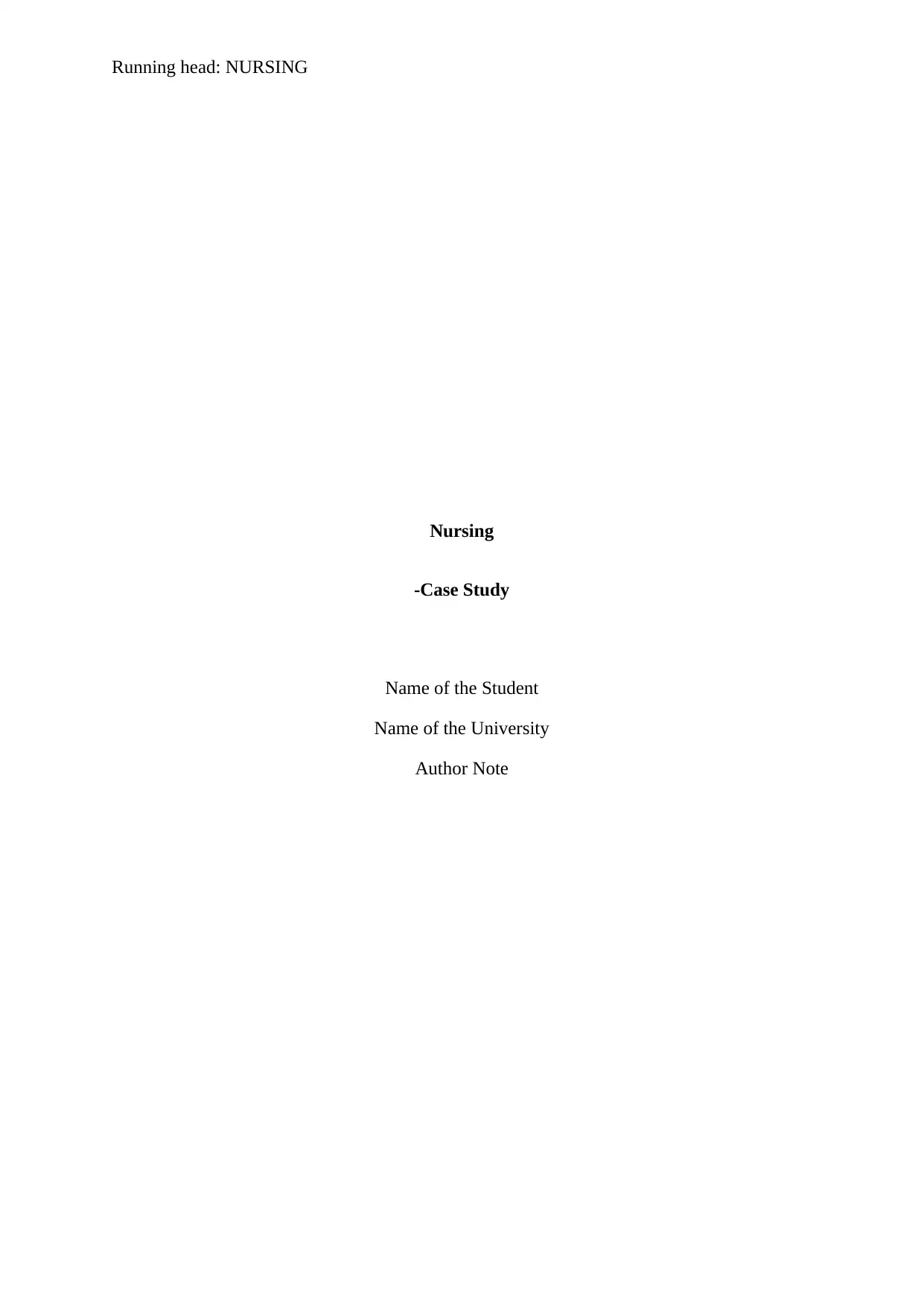
Running head: NURSING
Nursing
-Case Study
Name of the Student
Name of the University
Author Note
Nursing
-Case Study
Name of the Student
Name of the University
Author Note
Paraphrase This Document
Need a fresh take? Get an instant paraphrase of this document with our AI Paraphraser
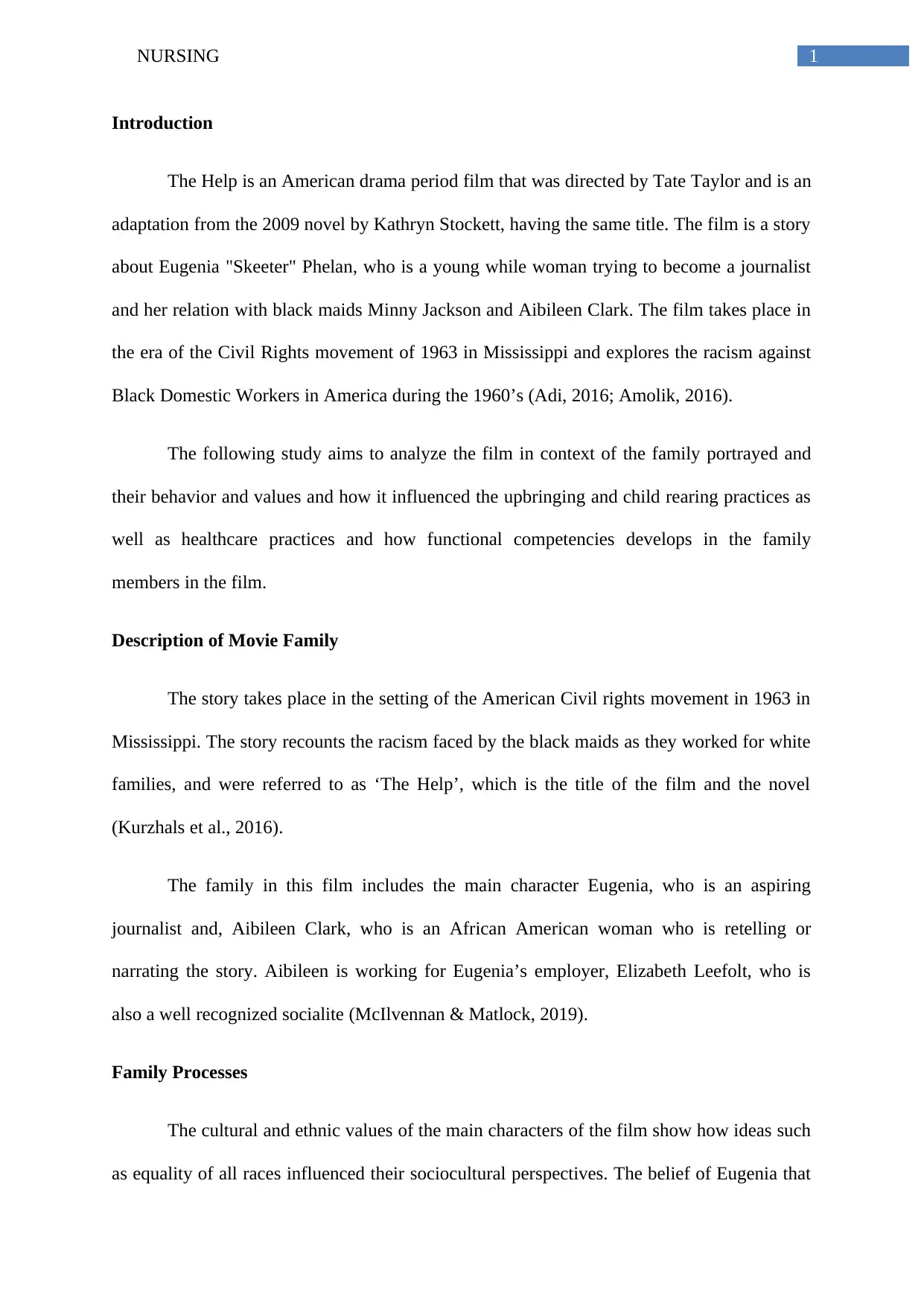
1NURSING
Introduction
The Help is an American drama period film that was directed by Tate Taylor and is an
adaptation from the 2009 novel by Kathryn Stockett, having the same title. The film is a story
about Eugenia "Skeeter" Phelan, who is a young while woman trying to become a journalist
and her relation with black maids Minny Jackson and Aibileen Clark. The film takes place in
the era of the Civil Rights movement of 1963 in Mississippi and explores the racism against
Black Domestic Workers in America during the 1960’s (Adi, 2016; Amolik, 2016).
The following study aims to analyze the film in context of the family portrayed and
their behavior and values and how it influenced the upbringing and child rearing practices as
well as healthcare practices and how functional competencies develops in the family
members in the film.
Description of Movie Family
The story takes place in the setting of the American Civil rights movement in 1963 in
Mississippi. The story recounts the racism faced by the black maids as they worked for white
families, and were referred to as ‘The Help’, which is the title of the film and the novel
(Kurzhals et al., 2016).
The family in this film includes the main character Eugenia, who is an aspiring
journalist and, Aibileen Clark, who is an African American woman who is retelling or
narrating the story. Aibileen is working for Eugenia’s employer, Elizabeth Leefolt, who is
also a well recognized socialite (McIlvennan & Matlock, 2019).
Family Processes
The cultural and ethnic values of the main characters of the film show how ideas such
as equality of all races influenced their sociocultural perspectives. The belief of Eugenia that
Introduction
The Help is an American drama period film that was directed by Tate Taylor and is an
adaptation from the 2009 novel by Kathryn Stockett, having the same title. The film is a story
about Eugenia "Skeeter" Phelan, who is a young while woman trying to become a journalist
and her relation with black maids Minny Jackson and Aibileen Clark. The film takes place in
the era of the Civil Rights movement of 1963 in Mississippi and explores the racism against
Black Domestic Workers in America during the 1960’s (Adi, 2016; Amolik, 2016).
The following study aims to analyze the film in context of the family portrayed and
their behavior and values and how it influenced the upbringing and child rearing practices as
well as healthcare practices and how functional competencies develops in the family
members in the film.
Description of Movie Family
The story takes place in the setting of the American Civil rights movement in 1963 in
Mississippi. The story recounts the racism faced by the black maids as they worked for white
families, and were referred to as ‘The Help’, which is the title of the film and the novel
(Kurzhals et al., 2016).
The family in this film includes the main character Eugenia, who is an aspiring
journalist and, Aibileen Clark, who is an African American woman who is retelling or
narrating the story. Aibileen is working for Eugenia’s employer, Elizabeth Leefolt, who is
also a well recognized socialite (McIlvennan & Matlock, 2019).
Family Processes
The cultural and ethnic values of the main characters of the film show how ideas such
as equality of all races influenced their sociocultural perspectives. The belief of Eugenia that
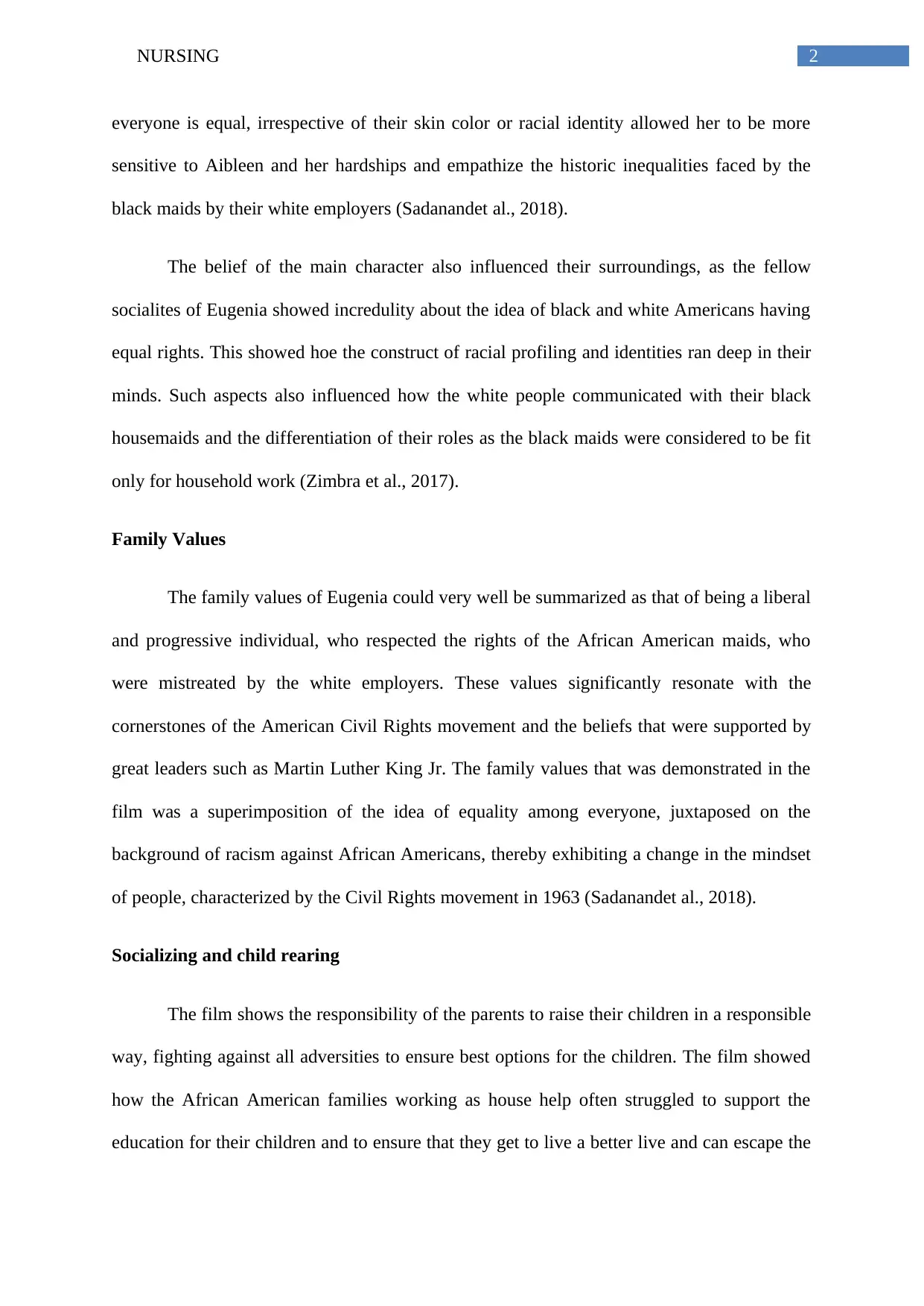
2NURSING
everyone is equal, irrespective of their skin color or racial identity allowed her to be more
sensitive to Aibleen and her hardships and empathize the historic inequalities faced by the
black maids by their white employers (Sadanandet al., 2018).
The belief of the main character also influenced their surroundings, as the fellow
socialites of Eugenia showed incredulity about the idea of black and white Americans having
equal rights. This showed hoe the construct of racial profiling and identities ran deep in their
minds. Such aspects also influenced how the white people communicated with their black
housemaids and the differentiation of their roles as the black maids were considered to be fit
only for household work (Zimbra et al., 2017).
Family Values
The family values of Eugenia could very well be summarized as that of being a liberal
and progressive individual, who respected the rights of the African American maids, who
were mistreated by the white employers. These values significantly resonate with the
cornerstones of the American Civil Rights movement and the beliefs that were supported by
great leaders such as Martin Luther King Jr. The family values that was demonstrated in the
film was a superimposition of the idea of equality among everyone, juxtaposed on the
background of racism against African Americans, thereby exhibiting a change in the mindset
of people, characterized by the Civil Rights movement in 1963 (Sadanandet al., 2018).
Socializing and child rearing
The film shows the responsibility of the parents to raise their children in a responsible
way, fighting against all adversities to ensure best options for the children. The film showed
how the African American families working as house help often struggled to support the
education for their children and to ensure that they get to live a better live and can escape the
everyone is equal, irrespective of their skin color or racial identity allowed her to be more
sensitive to Aibleen and her hardships and empathize the historic inequalities faced by the
black maids by their white employers (Sadanandet al., 2018).
The belief of the main character also influenced their surroundings, as the fellow
socialites of Eugenia showed incredulity about the idea of black and white Americans having
equal rights. This showed hoe the construct of racial profiling and identities ran deep in their
minds. Such aspects also influenced how the white people communicated with their black
housemaids and the differentiation of their roles as the black maids were considered to be fit
only for household work (Zimbra et al., 2017).
Family Values
The family values of Eugenia could very well be summarized as that of being a liberal
and progressive individual, who respected the rights of the African American maids, who
were mistreated by the white employers. These values significantly resonate with the
cornerstones of the American Civil Rights movement and the beliefs that were supported by
great leaders such as Martin Luther King Jr. The family values that was demonstrated in the
film was a superimposition of the idea of equality among everyone, juxtaposed on the
background of racism against African Americans, thereby exhibiting a change in the mindset
of people, characterized by the Civil Rights movement in 1963 (Sadanandet al., 2018).
Socializing and child rearing
The film shows the responsibility of the parents to raise their children in a responsible
way, fighting against all adversities to ensure best options for the children. The film showed
how the African American families working as house help often struggled to support the
education for their children and to ensure that they get to live a better live and can escape the
⊘ This is a preview!⊘
Do you want full access?
Subscribe today to unlock all pages.

Trusted by 1+ million students worldwide
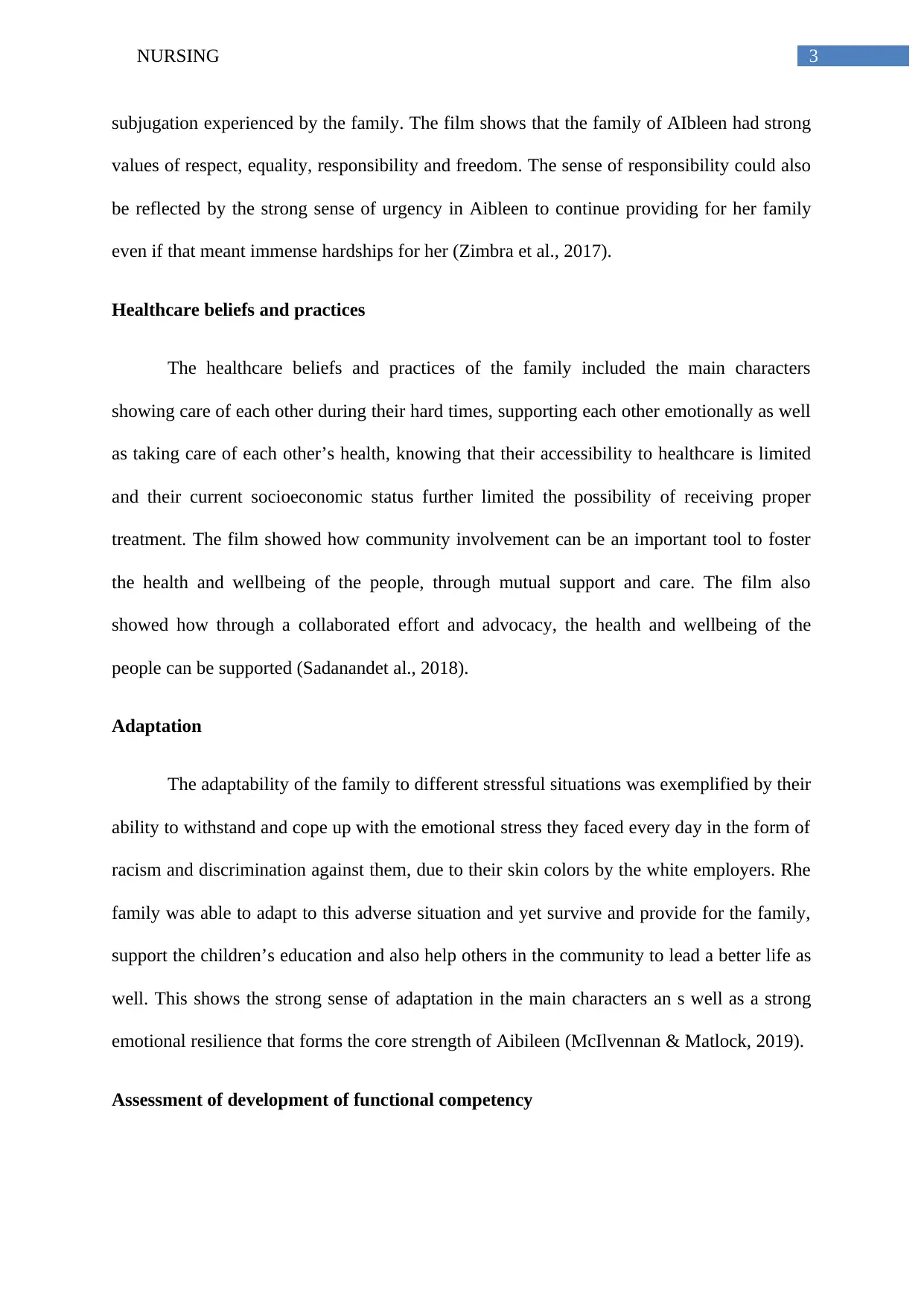
3NURSING
subjugation experienced by the family. The film shows that the family of AIbleen had strong
values of respect, equality, responsibility and freedom. The sense of responsibility could also
be reflected by the strong sense of urgency in Aibleen to continue providing for her family
even if that meant immense hardships for her (Zimbra et al., 2017).
Healthcare beliefs and practices
The healthcare beliefs and practices of the family included the main characters
showing care of each other during their hard times, supporting each other emotionally as well
as taking care of each other’s health, knowing that their accessibility to healthcare is limited
and their current socioeconomic status further limited the possibility of receiving proper
treatment. The film showed how community involvement can be an important tool to foster
the health and wellbeing of the people, through mutual support and care. The film also
showed how through a collaborated effort and advocacy, the health and wellbeing of the
people can be supported (Sadanandet al., 2018).
Adaptation
The adaptability of the family to different stressful situations was exemplified by their
ability to withstand and cope up with the emotional stress they faced every day in the form of
racism and discrimination against them, due to their skin colors by the white employers. Rhe
family was able to adapt to this adverse situation and yet survive and provide for the family,
support the children’s education and also help others in the community to lead a better life as
well. This shows the strong sense of adaptation in the main characters an s well as a strong
emotional resilience that forms the core strength of Aibileen (McIlvennan & Matlock, 2019).
Assessment of development of functional competency
subjugation experienced by the family. The film shows that the family of AIbleen had strong
values of respect, equality, responsibility and freedom. The sense of responsibility could also
be reflected by the strong sense of urgency in Aibleen to continue providing for her family
even if that meant immense hardships for her (Zimbra et al., 2017).
Healthcare beliefs and practices
The healthcare beliefs and practices of the family included the main characters
showing care of each other during their hard times, supporting each other emotionally as well
as taking care of each other’s health, knowing that their accessibility to healthcare is limited
and their current socioeconomic status further limited the possibility of receiving proper
treatment. The film showed how community involvement can be an important tool to foster
the health and wellbeing of the people, through mutual support and care. The film also
showed how through a collaborated effort and advocacy, the health and wellbeing of the
people can be supported (Sadanandet al., 2018).
Adaptation
The adaptability of the family to different stressful situations was exemplified by their
ability to withstand and cope up with the emotional stress they faced every day in the form of
racism and discrimination against them, due to their skin colors by the white employers. Rhe
family was able to adapt to this adverse situation and yet survive and provide for the family,
support the children’s education and also help others in the community to lead a better life as
well. This shows the strong sense of adaptation in the main characters an s well as a strong
emotional resilience that forms the core strength of Aibileen (McIlvennan & Matlock, 2019).
Assessment of development of functional competency
Paraphrase This Document
Need a fresh take? Get an instant paraphrase of this document with our AI Paraphraser
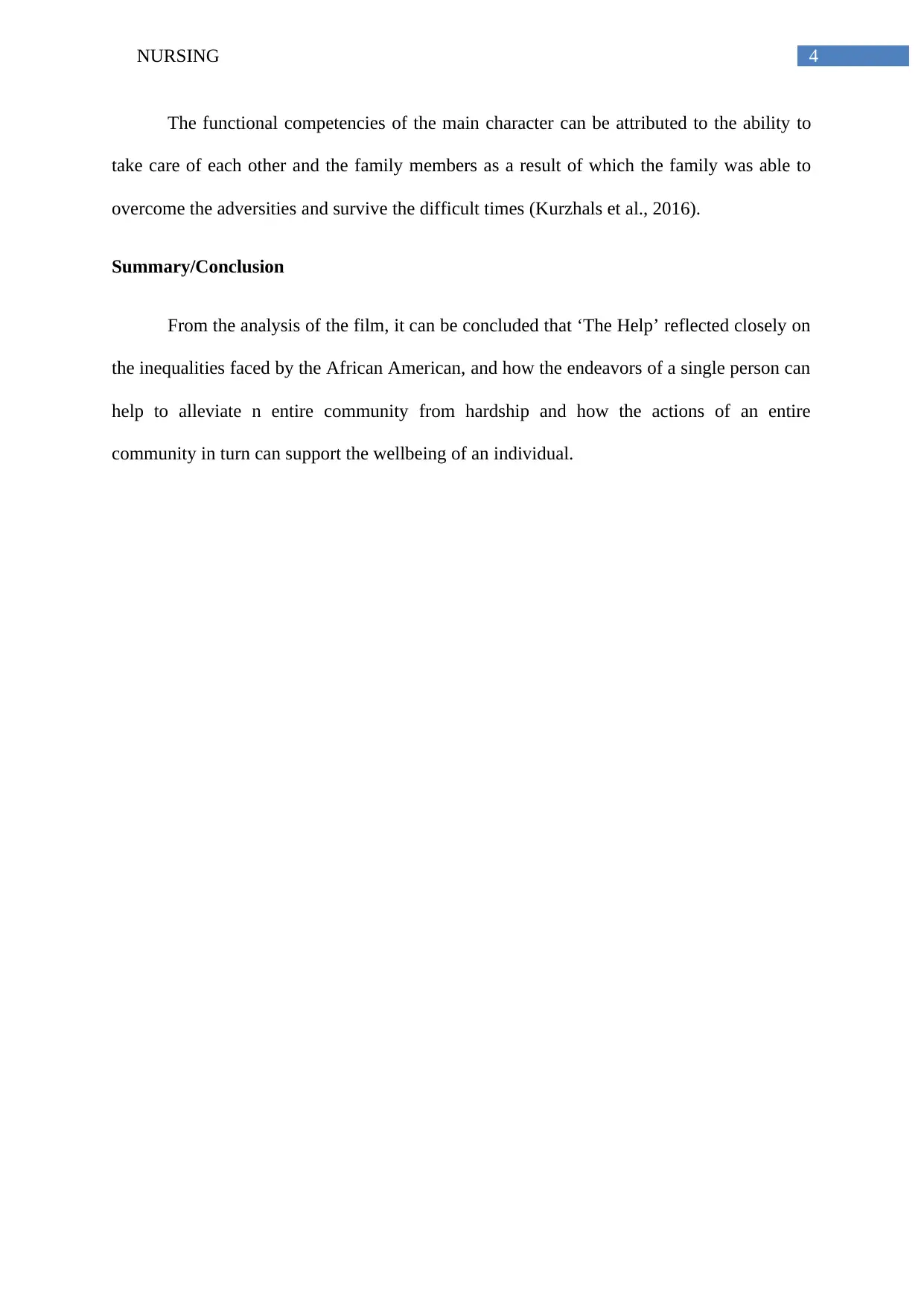
4NURSING
The functional competencies of the main character can be attributed to the ability to
take care of each other and the family members as a result of which the family was able to
overcome the adversities and survive the difficult times (Kurzhals et al., 2016).
Summary/Conclusion
From the analysis of the film, it can be concluded that ‘The Help’ reflected closely on
the inequalities faced by the African American, and how the endeavors of a single person can
help to alleviate n entire community from hardship and how the actions of an entire
community in turn can support the wellbeing of an individual.
The functional competencies of the main character can be attributed to the ability to
take care of each other and the family members as a result of which the family was able to
overcome the adversities and survive the difficult times (Kurzhals et al., 2016).
Summary/Conclusion
From the analysis of the film, it can be concluded that ‘The Help’ reflected closely on
the inequalities faced by the African American, and how the endeavors of a single person can
help to alleviate n entire community from hardship and how the actions of an entire
community in turn can support the wellbeing of an individual.
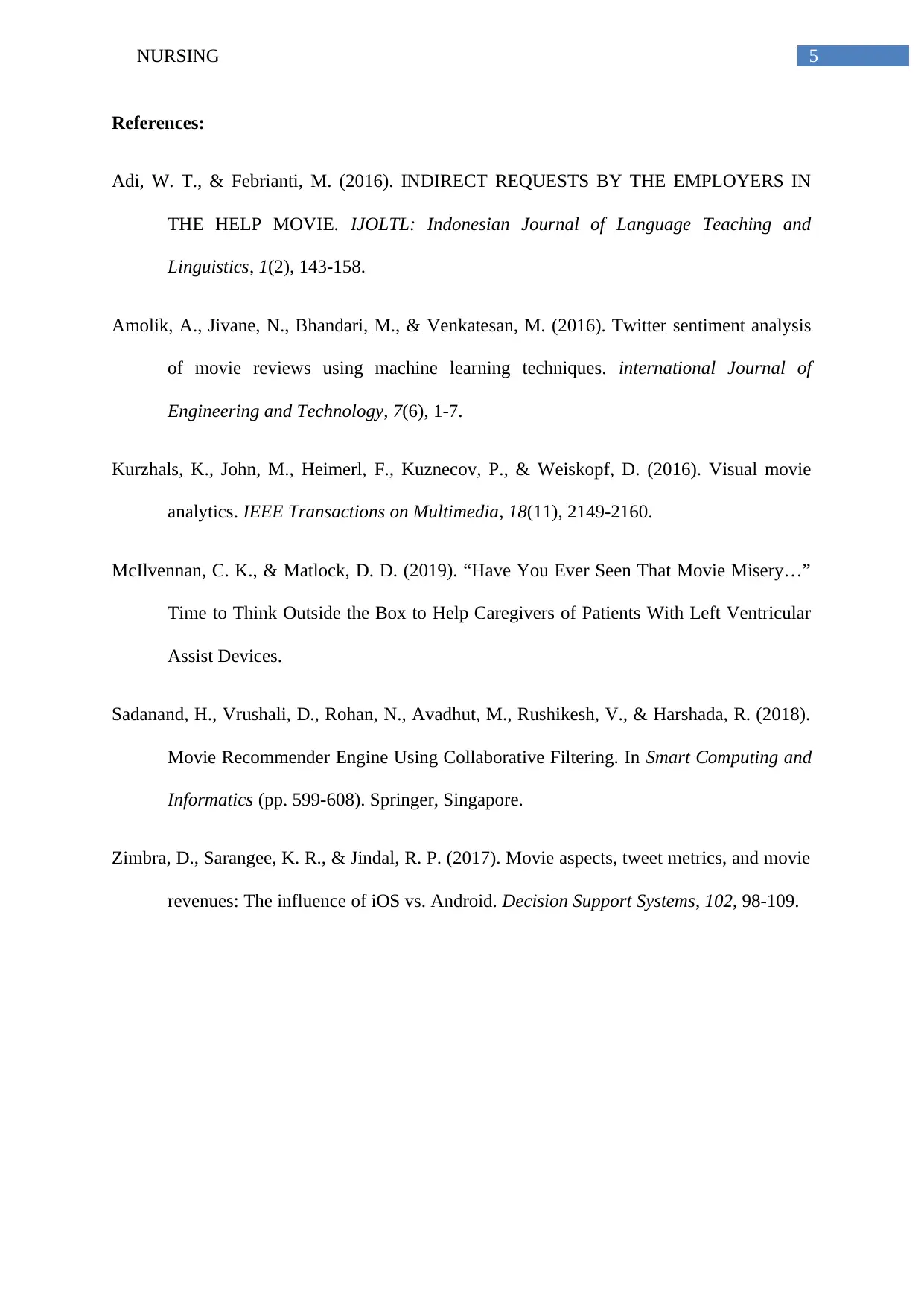
5NURSING
References:
Adi, W. T., & Febrianti, M. (2016). INDIRECT REQUESTS BY THE EMPLOYERS IN
THE HELP MOVIE. IJOLTL: Indonesian Journal of Language Teaching and
Linguistics, 1(2), 143-158.
Amolik, A., Jivane, N., Bhandari, M., & Venkatesan, M. (2016). Twitter sentiment analysis
of movie reviews using machine learning techniques. international Journal of
Engineering and Technology, 7(6), 1-7.
Kurzhals, K., John, M., Heimerl, F., Kuznecov, P., & Weiskopf, D. (2016). Visual movie
analytics. IEEE Transactions on Multimedia, 18(11), 2149-2160.
McIlvennan, C. K., & Matlock, D. D. (2019). “Have You Ever Seen That Movie Misery…”
Time to Think Outside the Box to Help Caregivers of Patients With Left Ventricular
Assist Devices.
Sadanand, H., Vrushali, D., Rohan, N., Avadhut, M., Rushikesh, V., & Harshada, R. (2018).
Movie Recommender Engine Using Collaborative Filtering. In Smart Computing and
Informatics (pp. 599-608). Springer, Singapore.
Zimbra, D., Sarangee, K. R., & Jindal, R. P. (2017). Movie aspects, tweet metrics, and movie
revenues: The influence of iOS vs. Android. Decision Support Systems, 102, 98-109.
References:
Adi, W. T., & Febrianti, M. (2016). INDIRECT REQUESTS BY THE EMPLOYERS IN
THE HELP MOVIE. IJOLTL: Indonesian Journal of Language Teaching and
Linguistics, 1(2), 143-158.
Amolik, A., Jivane, N., Bhandari, M., & Venkatesan, M. (2016). Twitter sentiment analysis
of movie reviews using machine learning techniques. international Journal of
Engineering and Technology, 7(6), 1-7.
Kurzhals, K., John, M., Heimerl, F., Kuznecov, P., & Weiskopf, D. (2016). Visual movie
analytics. IEEE Transactions on Multimedia, 18(11), 2149-2160.
McIlvennan, C. K., & Matlock, D. D. (2019). “Have You Ever Seen That Movie Misery…”
Time to Think Outside the Box to Help Caregivers of Patients With Left Ventricular
Assist Devices.
Sadanand, H., Vrushali, D., Rohan, N., Avadhut, M., Rushikesh, V., & Harshada, R. (2018).
Movie Recommender Engine Using Collaborative Filtering. In Smart Computing and
Informatics (pp. 599-608). Springer, Singapore.
Zimbra, D., Sarangee, K. R., & Jindal, R. P. (2017). Movie aspects, tweet metrics, and movie
revenues: The influence of iOS vs. Android. Decision Support Systems, 102, 98-109.
⊘ This is a preview!⊘
Do you want full access?
Subscribe today to unlock all pages.

Trusted by 1+ million students worldwide

6NURSING
1 out of 7
Related Documents
Your All-in-One AI-Powered Toolkit for Academic Success.
+13062052269
info@desklib.com
Available 24*7 on WhatsApp / Email
![[object Object]](/_next/static/media/star-bottom.7253800d.svg)
Unlock your academic potential
Copyright © 2020–2025 A2Z Services. All Rights Reserved. Developed and managed by ZUCOL.



